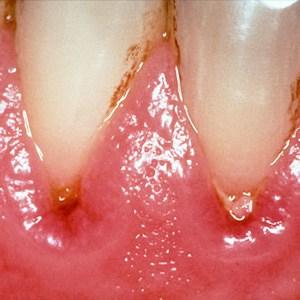If you’re American and over 30, you’ve probably got periodontal disease to one degree or another. As many as 75% do. If your gums look red and puffy, or if they bleed when you brush or floss, bingo – you’re in the majority.
But just because something is the norm doesn’t mean that it’s good or desirable. This is an infectious disease we’re talking about, after all – one that may elevate your risk for all sorts of systemic health conditions. Heart disease and stroke. Diabetes. Alzheimer’s. Cancer.
Gum disease. Do not want.
 The good news is that in its early stages – when the condition is referred to as gingitivis – it’s easily treatable and reversible. No major damage has been done.
The good news is that in its early stages – when the condition is referred to as gingitivis – it’s easily treatable and reversible. No major damage has been done.
But if gingivitis is left untreated, it becomes periodontitis. The infection spreads into the deeper tissues that support your teeth. Toxins generated by bacteria, as well as your own body in its effort to fight them, gradually wear down the bone and connective tissue. As they lose this supportive structure, your teeth begin to loosen. Eventually, they may fall out – or a periodontist may recommend extracting them.
According to new research in the Journal of Periodontology, almost half of all US adults have this more severe form of gum disease – 46%, to be exact. Among older adults – those over the age of 65 – the rate is even higher: 68%.
Unsurprisingly, smokers are among those with the highest rates of periodontitis. Smoking is the number one risk factor for developing the disease. But rates are also considerably higher for Latinos and African-Americans than other groups, at 63.5% and 59.1%, respectively.
Why are rates so high? Along with smoking, at least one author points to the fact that, as the latest CDC data shows, we’re living longer and keeping more of our natural teeth as we age. “As we retain more teeth,” he told DrBicuspid, “we have more teeth that become susceptible to periodontal disease. So it makes it important for us to continually practice good oral hygiene throughout our life span.”
Interestingly, the gum disease numbers seem to roughly correspond with those of another ongoing health issue: obesity. According to the CDC, 69% of American adults are overweight, with 35.1% considered obese. Like periodontitis, obesity is an inflammatory connection. So we shouldn’t be surprised to find relationships between the two.
And a great deal of recent scientific research has confirmed this association. One of the latest research reviews, just published in the Journal of Clinical Periodontology, found an association between weight gain and the development of periodontitis. A similar review of scientific literature found that
overweight, obesity, weight gain, and increased waist circumference may be risk factors for development of periodontitis or worsening of periodontal measures.
There are some studies that give different results. For instance, one published earlier this year in Obesity Research and Clinical Practice found no greater prevalence of periodontitis among heavier postmenopausal women. What the authors did find is that those who had the disease had it worse than their lower weight counterparts.
Fortunately, there are good solutions available for getting the better of periodontitis. Simply shifting to an anti-inflammatory diet can be a big help. Step number one is to cut out added sugars and other refined carbohydrates, replacing them with vegetables and other real foods such as legumes, nuts, whole grains, healthy fats and the like. It’s a point that can’t be stressed enough.
Supplement therapy may also be useful. This can include a wide variety of antioxidants such as curcumin – the main compound in turmeric – which research has shown effective for improving periodontal health. Addressing issues like chronic stress and chronic sleep debt – both of which fuel inflammation – is also beneficial.
Then there are dental interventions such as ozone, which is extremely powerful in controlling the spread of the pathogens that contribute to gum disease and improving the health of the soft tissues. Another option is laser therapy which – unlike traditional periodontal surgery – provides deep and thorough cleaning in a non-invasive way. There is also some early evidence that the laser can stimulate new bone growth in the jaw, providing new support for vulnerable teeth.
But best of all is to deal with any gum disease before it progresses to the severe stage. After all, the easiest way to deal with a problem is to never have it in the first place.
Image by AJC, via Flickr